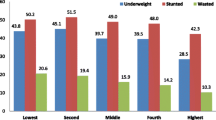Abstract
Objective
To evaluate the growth and nutritional status at term (39–41 weeks) corrected gestational age in VLBW infants and to study the predictors of malnutrition.
Methods
This Cross-sectional study was conducted in a tertiary care perinatal centre with level III NICU. All Inborn VLBW infants who were discharged alive from the hospital during the study period from January 2008 through June 2009 were included in this study. Relevant perinatal, clinical and anthropometry data were collected at birth, at hospital discharge and at term gestation. Primary outcome was considered as Z scores of weight, occipitofrontal circumference, length and predictors of postnatal malnutrition (z-score for weight ≤2SD) at term gestation.
Results
The mean gestational age and the mean birth weight of study subjects were 31.03 ± 2.18 weeks and 1195.28 ± 191.25 g respectively. Twenty-six (15%) infants had birth weight less than 1,000 g and 65 (37.4%) infants were of gestation less than 31 weeks. The mean weight, the mean length and mean occipitofrontal circumference (OFC) at term gestation were 2367.32 ± 521 g, 43.72 ± 3.3 cm and 32.65 ± 1.6 cm respectively. The mean z scores for weight, length and OFC at term gestation was −1.66 ± 1.2, −1.98 ± 1.3 and −0.48 ± 0.7 respectively. Forty three percent (n = 75) infants were malnourished. Birth weight (p = 0.005), gestational age (p = 0.001), z-score at birth (p = 0.001), female sex (p = 0.004), duration of oxygen (p = 0.008), duration of hospitalization (p = 0.005) and average post discharge weight gain per day (p < 0.001) predicted malnutrition.
Conclusions
There is a high prevalence of postnatal malnutrition in VLBW infants. Poor intrauterine growth, female sex, lower birth weight, lower gestation, infant sickness and poor post-discharge weight gain contribute significantly to postnatal malnutrition



Similar content being viewed by others
References
Lucas A. Role of nutritional programming in determining adult morbidity. Arch Dis Child. 1994;71:288–90.
Barker DJ. Fetal growth and adult disease. Br J Obstet Gynaecol. 1992;99:275–6.
Lucas A, Morley R, Cole TJ, et al. Early diet in preterm babies and development status at 18 months. Lancet. 1990;335:1477–81.
Hack M, Schluchter M, Cartar L, Rahman M, Cuttler L, Borawski E. Growth of very low birth weight infants to age 20 years. Pediatrics. 2003;112:e30–8.
Sridhar K, Bhat BV, Srinivasan S. Growth pattern of low birth weight babies in the first year of life. Indian J Pediatr. 2002;69:485–8.
Kalra SK, Sarkar P, Vatwani V, De NC. A longitudinal study of low birth weight babies. Indian J Pediatr. 1983;50:279–83.
Hack M, Weissman B, Borawski-Clark E. Catch-up growth during childhood among very low-birth-weight children. Arch Pediatr Adolesc Med. 1996;150:1122–9.
Sices L, Wilson-Costello D, Minich N, Friedman H, Hack M. Postdischarge growth failure among extremely low birth weight infants: Correlates and consequences. Paediatr Child Health. 2007;12:22–8.
Report of the National Neonatal Perinatal Database. National Neonatology Forum, India, 2002–2003.
Singh M, Paul VK, Deorari AK, Singhal PK. Changing trends in intrauterine growth curves. Indian Pediatr. 1991;28:281–3.
Ghosh S, Bhargava SK, Madhavan S, Taskar AD, Bhargava V, Nigam SK. Intrauterine growth of north Indian babies. Pediatrics. 1971;47:826–32.
Gianini NM, Vieira AA, Moreira ME. Evaluation of the nutritional status at 40 weeks corrected gestational age in a cohort of very low birth weight infants. J Pediatr (Rio J). 2005;81:34–40.
Dinerstein A, Nieto RN, Solano CL, Perez GP, Otheguy LE, Larguia AM. Early aggressive nutritional strategy will decrease postnatal growth failure in VLBW infants. J Perinatol. 2006;26:436–42.
Ramji S. Enteral feeding of low birth weight infants. Indian J Pediatr. 2002;69:401–4.
Kumar P, Sankar MJ, Sapra S, Agarwal R, Deorari AK, Paul VK. Follow-up of high risk neonates. Indian J Pediatr. 2008;75:479–87.
Ehrenkranz RA, Younes N, Lemons JA, et al. Longitudinal growth of hospitalized very low birth weight infants. Pediatrics. 1999;104:280–9.
Saigal S, Stoskopf BL, Streiner DL, Burrows E. Physical growth and current health status of infants who were of extremely low birth weight and control at adolescence. Pediatrics. 2001;108:407–15.
Contributions
SM designed and supervised the study. AJ collected and analyzed the data. All the authors were involved in writing the manuscript.
Conflict of Interest
None.
Role of Funding Source
None.
Author information
Authors and Affiliations
Corresponding author
Rights and permissions
About this article
Cite this article
Jaiswal, A., Reddy, A., Gaddam, P. et al. Growth and Nutritional Status at Corrected Term Gestational Age in Very Low Birth Weight Infants. Indian J Pediatr 78, 673–678 (2011). https://doi.org/10.1007/s12098-010-0347-z
Received:
Accepted:
Published:
Issue Date:
DOI: https://doi.org/10.1007/s12098-010-0347-z




